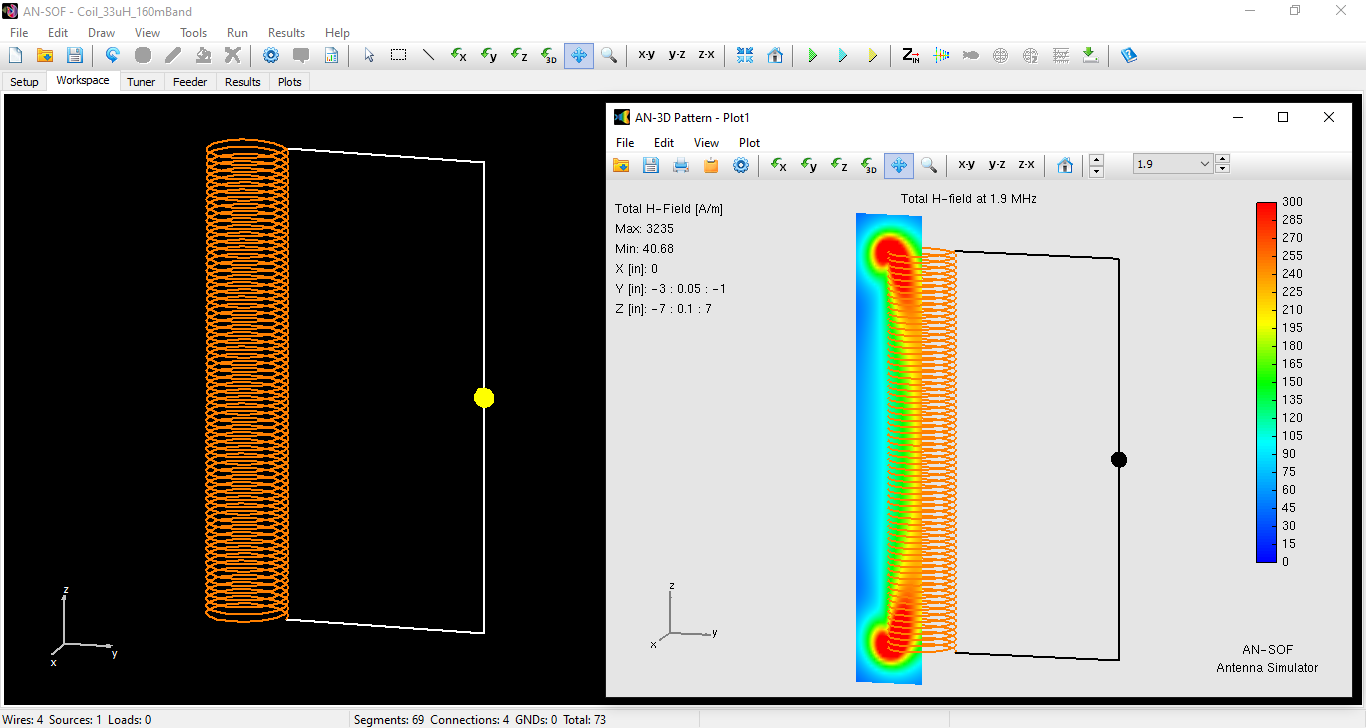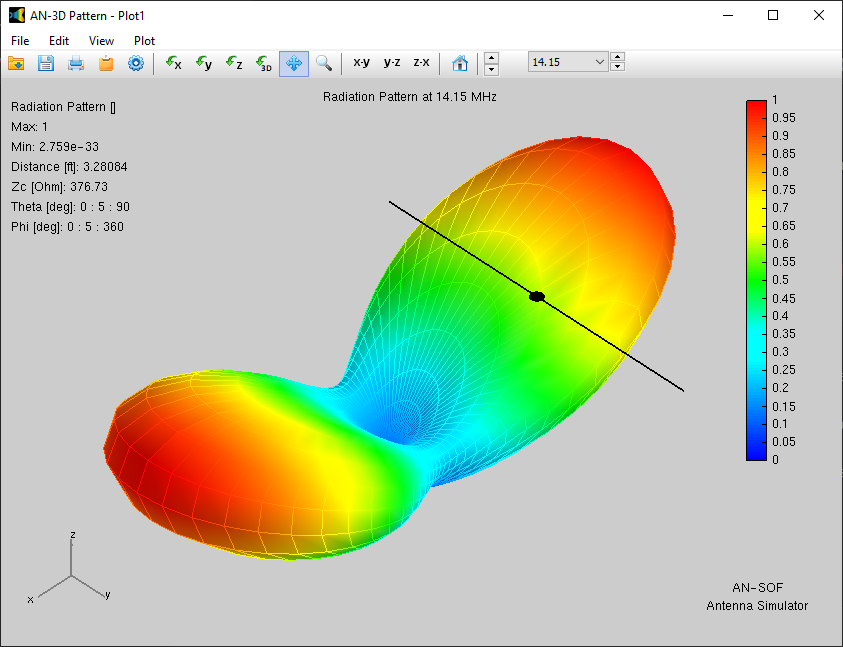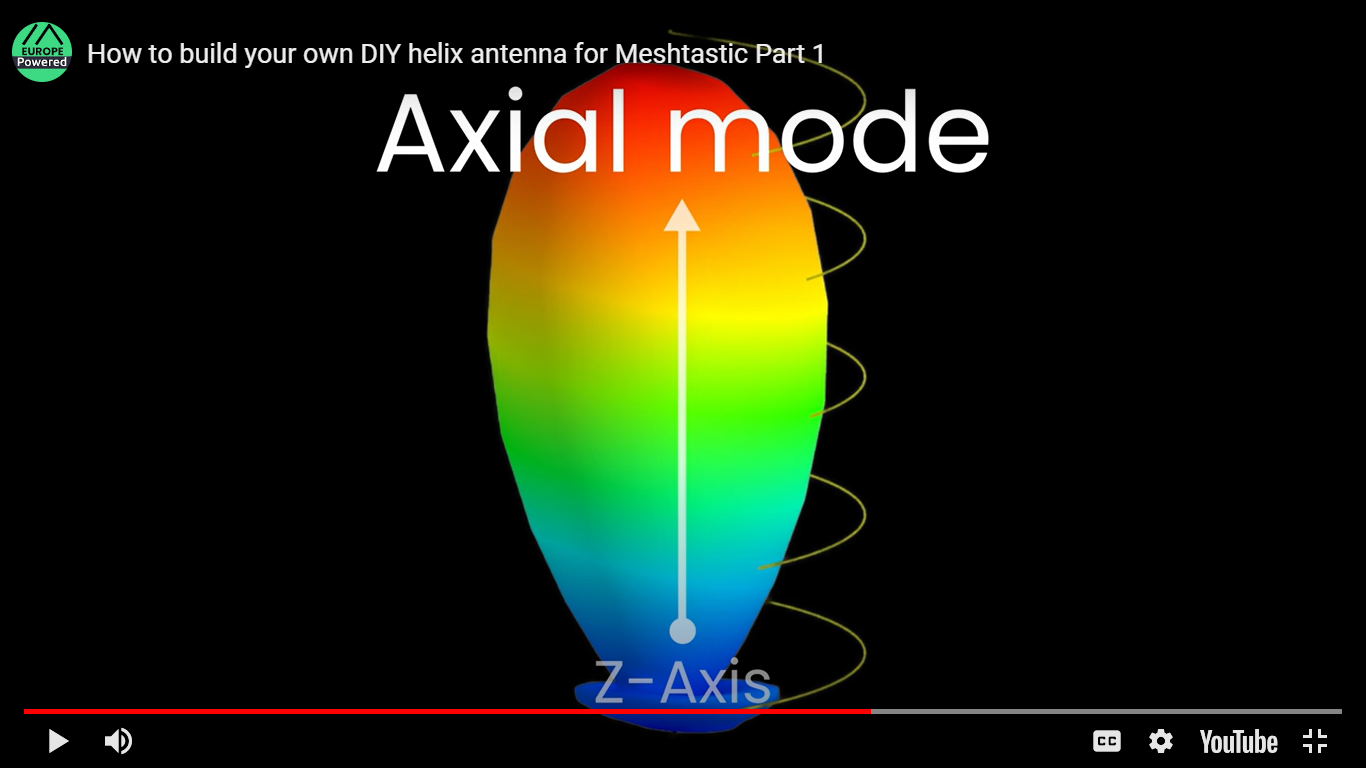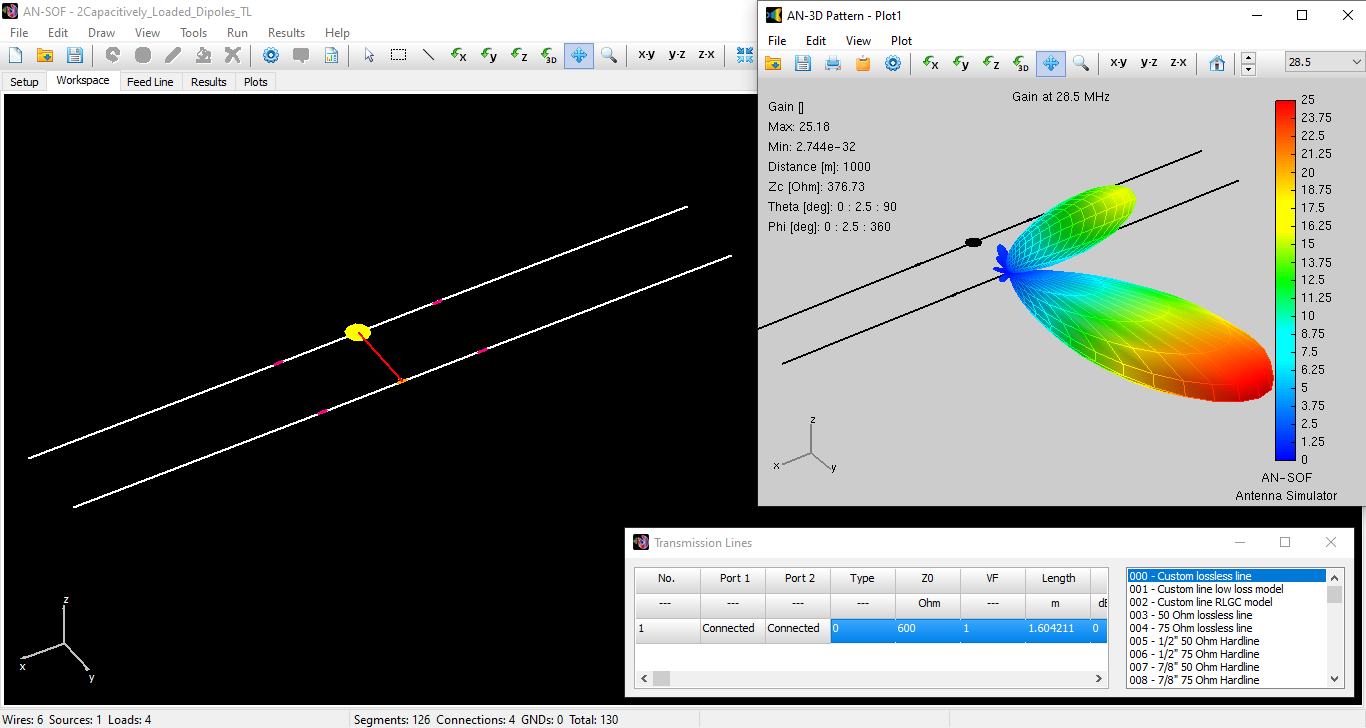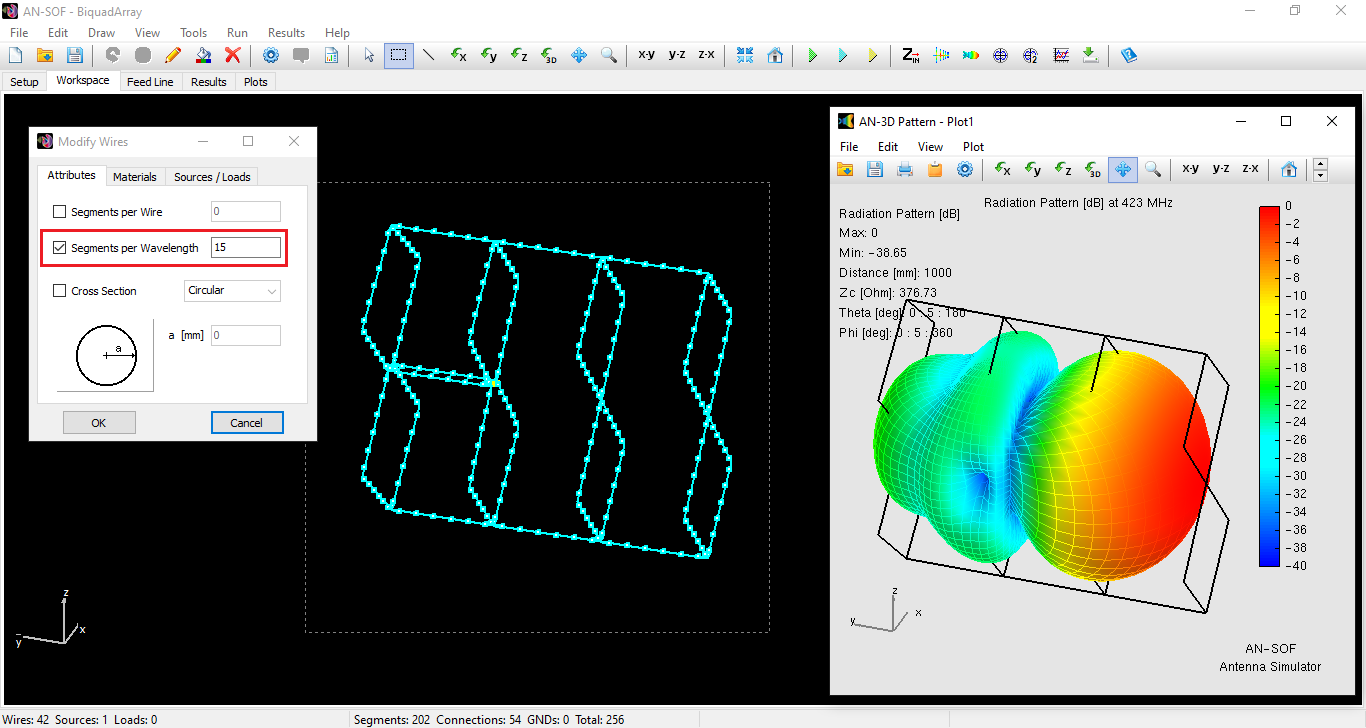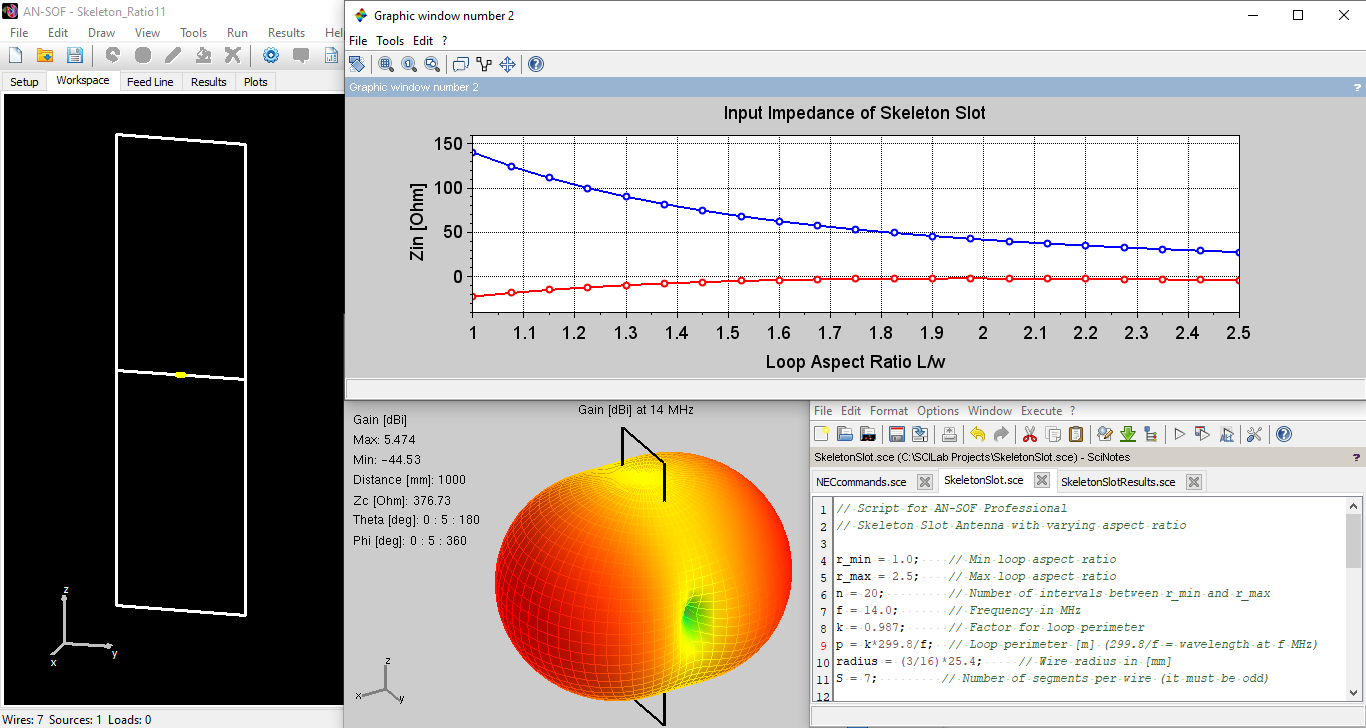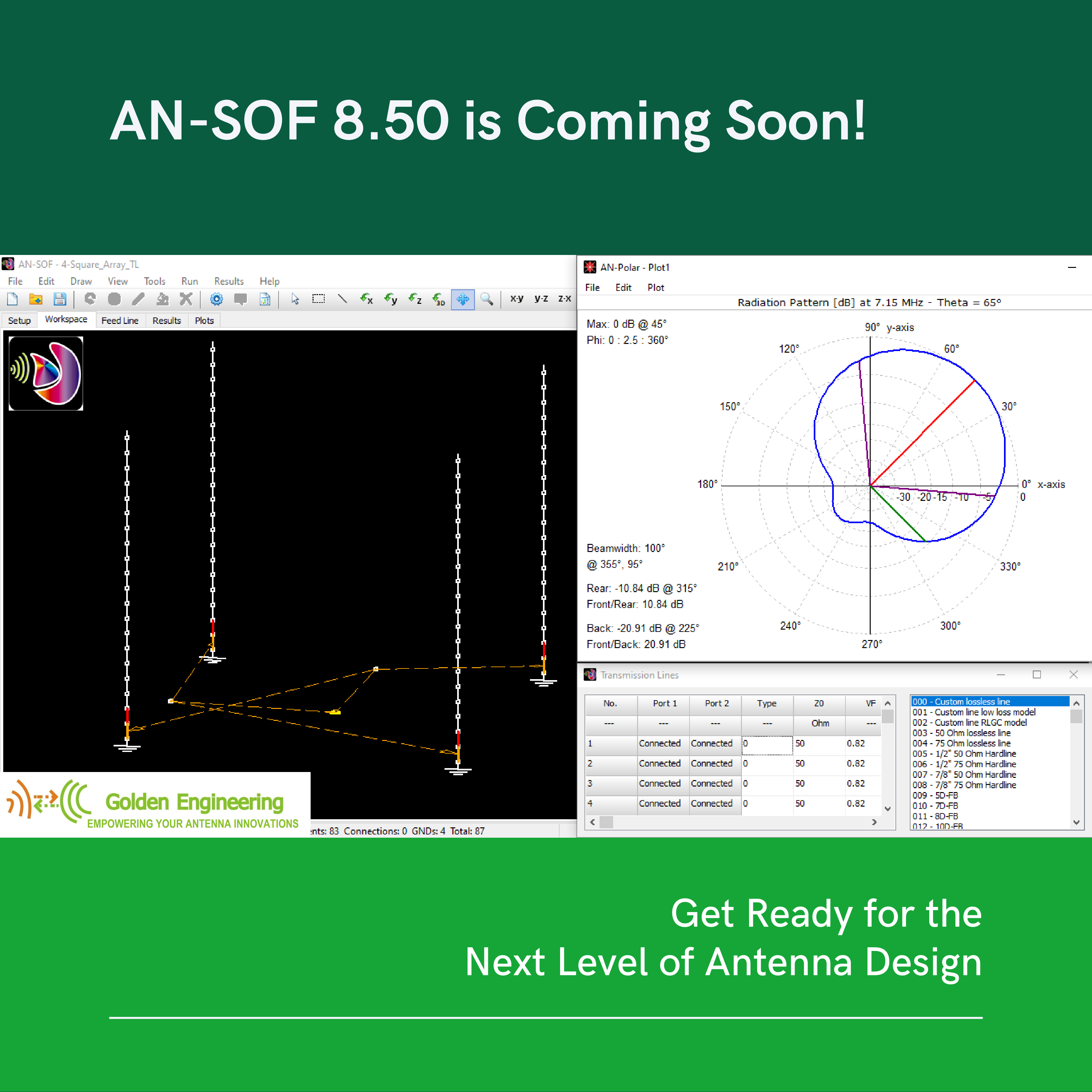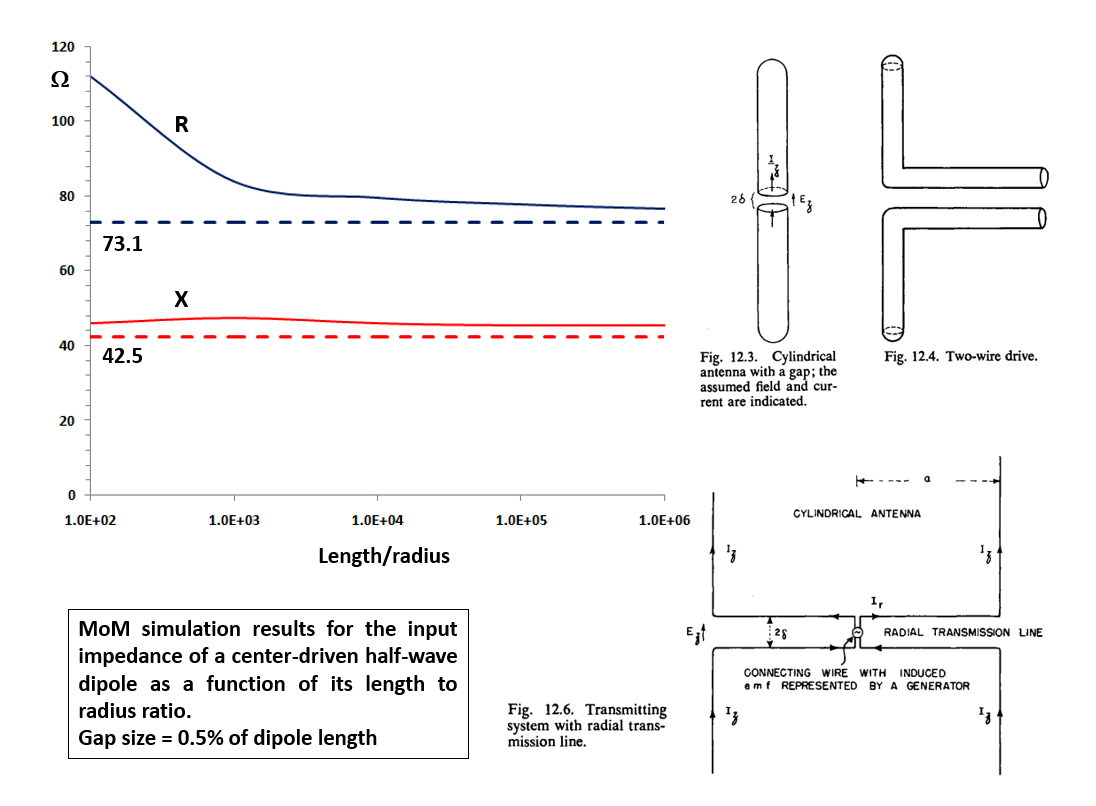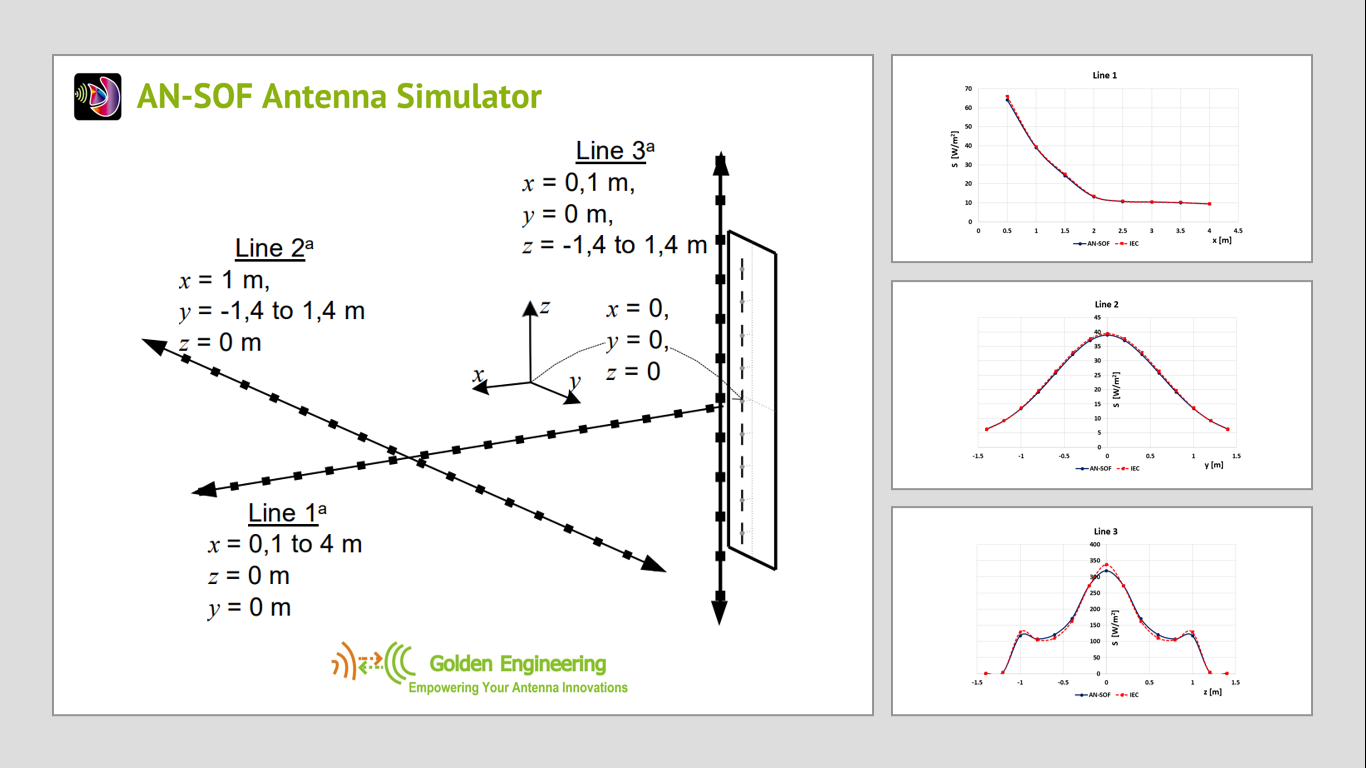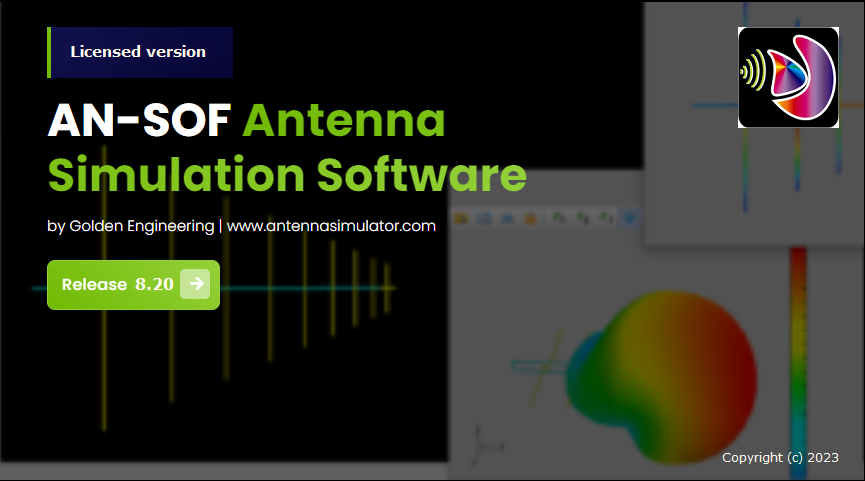Antennas and Beyond!
This is a blog dedicated to exploring the fascinating world of antenna design and simulation. Whether you’re a beginner or an experienced engineer, you’ll find valuable insights into antenna modeling, theory, numerical methods, and practical examples of antenna models using AN-SOF Antenna Simulation Software.
Featured
-

Evaluating EMF Compliance – Part 2: Using Near-Field Calculations to Determine Exclusion Zones
In this article, we dive deep into near-field calculations to establish RF exclusion zones. By understanding near-field and far-field regions, occupational vs. public exposure, health impacts, and practical methods, we ensure compliance with EMF guidelines and safeguard human health.
-

AN-SOF 9.50 Release: Streamlining Polarization, Geometry, and EMF Calculations
We’re thrilled to announce AN-SOF 9.50, packed with user-requested enhancements. Improved geometry input, simplified polarization analysis, and new EMF compliance tools make antenna design easier and more precise than ever. Upgrade your design process with AN-SOF 9.50!
-

Evaluating EMF Compliance – Part 1: A Guide to Far-Field RF Exposure Assessments
In today’s wireless world, ensuring Electromagnetic Field (EMF) compliance is crucial for protecting individuals from potential harmful effects of RF exposure. Join us as we explore the influence of antenna configurations, ground planes, and feed lines on far-field EIRP values, ensuring you possess the tools to navigate the complexities of EMF compliance effectively.
Subscribe to our free mailing list and be the first to receive new content as soon as it’s published on our blog Antennas and Beyond!
Sections
The Antenna Lab
Unlock the world of antenna design! This section offers engaging resources for educators and students, fostering a deeper understanding of antenna theory and practice.
The Ham’s Corner
Take your ham radio skills to the next level! This section offers practical tips, tutorials, and project ideas specifically designed for the needs and interests of radio enthusiasts.
Advanced RF Edge
Delve into the cutting edge of antenna design. This section explores industry trends, insightful case studies, and advanced technical insights to empower antenna professionals.
Categories
Adding Wire Grids/Solid Surfaces Adding Wires Antenna Feeder Calculator Apertures & Reflectors Array Antennas Background Theory Complex Environments Current Distribution Curved Antennas Displaying Results Drawing Wires Editing Wires FAQs Far Field Fractal Antennas Getting Started Grids and Surfaces Ground Planes Guides Guides & Tools Incident Field Input Impedances Linear Antennas Load Impedances Microstrip Antennas Modeling Guidelines Models Near Field Numerical Methods Release Notes Results Display Running Calculations Scripts Setup Guide Simulation Setup Sources and Loads Step By Step Transmission Lines Traveling Wave Validation Wire Antennas
Tags
advanced RF (13) antenna arrays (15) antenna design (8) antenna lab (18) blog (71) broadband (2) dipole (8) directional (16) featured (3) fractal (1) ham radio (24) helix (4) loop (11) microstrip (2) monopole (4) multiband (4) omnidirectional (13) quad (3) release notes (18) tips & tricks (12) transmission lines (4) validation (3) yagi (3)
Search
Recent Articles
-
Evaluating EMF Compliance – Part 2: Using Near-Field Calculations to Determine Exclusion Zones
In this article, we dive deep into near-field calculations to establish RF exclusion zones. By understanding near-field and far-field regions, occupational vs. public exposure, health impacts, and practical methods, we ensure compliance with EMF guidelines and safeguard human health.
-
AN-SOF 9.50 Release: Streamlining Polarization, Geometry, and EMF Calculations
We’re thrilled to announce AN-SOF 9.50, packed with user-requested enhancements. Improved geometry input, simplified polarization analysis, and new EMF compliance tools make antenna design easier and more precise than ever. Upgrade your design process with AN-SOF 9.50!
-
Beyond Analytical Formulas: Accurate Coil Inductance Calculation with AN-SOF
Traditional coil inductance calculations often rely on simplified approximations. AN-SOF offers a more accurate approach by considering factors like non-uniform magnetic fields, conductor losses, and complex coil geometries. By using AN-SOF, you can obtain precise inductance values, visualize magnetic field and current distributions, to improve your coil designs.
-
The Lazy-H Antenna: A 10-Meter Band Design Guide
Build a high-performance Lazy-H antenna for the 10-meter band. Learn to design and simulate your own antenna with this guide. Calculate performance with AN-SOF and discover the benefits of wide bandwidth and excellent gain. Watch the included video tutorial for step-by-step modeling.
-
Complete Workflow: Modeling, Feeding, and Tuning a 20m Band Dipole Antenna
Here is a comprehensive guide to modeling, feeding, and tuning half-wave dipoles, offering principles and techniques that can be applied to any antenna system.
-
DIY Helix High Gain Directional Antenna: From Simulation to 3D Printing
We are happy to share an interesting project by one of our AN-SOF users: @PoweredMeshtasticEurope. He demonstrates how to build your own helix high gain directional antenna for the Meshtastic frequency range, from theory to reality.
-
AN-SOF 9: Taking Antenna Design Further with New Feeder and Tuner Calculators
Discover the advanced features of AN-SOF 9, the latest version that takes antenna design to the next level with groundbreaking Feeder and Tuner Calculators.
-
Navigating the Numerical Landscape: Choosing the Right Antenna Simulation Method
Here we provide an overview of various numerical methods used in Computational Electromagnetics (CEM), with a special focus on antenna simulation methods: FDTD, FEM, MoM, CMoM, FMM, MLFMM, FVTD, GO, GTD, UTD, PO, PTD, DDM.
-
Extended Double Zepp (EDZ): A Phased Array Solution for Directional Antenna Applications
The Extended Double Zepp (EDZ) antenna offers higher gain than a half-wave dipole, but matching to 50-Ohm coax is difficult. This article explores a phased array design using two EDZs for directional radio transmission, achieving good gain and easier impedance matching.
-
Evaluating EMF Compliance – Part 1: A Guide to Far-Field RF Exposure Assessments
In today’s wireless world, ensuring Electromagnetic Field (EMF) compliance is crucial for protecting individuals from potential harmful effects of RF exposure. Join us as we explore the influence of antenna configurations, ground planes, and feed lines on far-field EIRP values, ensuring you possess the tools to navigate the complexities of EMF compliance effectively.
-
AN-SOF Antenna Simulation Software – Version 8.90 Release Notes
Exciting update! AN-SOF 8.90 is here with features like “Segments per Wavelength,” enhanced wire scaling, TL command import/export, and faster current distribution algorithms. Elevate your antenna simulations!
-
Design Guidelines for Skeleton Slot Antennas: A Simulation-Driven Approach
Dive into the intricacies of Skeleton Slot antennas. Explore optimal designs, balancing geometry parameters, and leveraging simulation tools. Ideal for both engineers and enthusiasts!
-
AN-SOF 8.70: Enhancing Your Antenna Design Journey
Experience antenna design at its best with AN-SOF 8.70, your comprehensive tool for simulation mastery.
-
Simple Dual Band Vertical Dipole for the 2m and 70cm Bands
Discover the perfect balance: a simple dual-band vertical dipole, AN-SOF modeling, and real-world results. Elevate your ham radio experience.
-
Accurate Analysis of Solid Wheel Antennas at 2.4 GHz Using Cost-Effective Simulation
Revolutionize antenna modeling with our simplified method. Accurately simulate 2.4 GHz wheel antennas for optimal performance.
-
Transmission Line Feeding for Antennas: The Four-Square Array
Explore the Four-Square Array antenna where implicit models of transmission lines are used in the feeding system of this phased array.
-
Simplified Modeling for Microstrip Antennas on Ungrounded Dielectric Substrates: Accuracy Meets Simplicity
Discover a simple yet precise method for modeling microstrip antennas on ungrounded dielectric substrates.
-
Fast Modeling of a Monopole Supported by a Broadcast Tower
Elevate your antenna design game with our latest video tutorial on monopole modeling using AN-SOF.
-
Linking Log-Periodic Antenna Elements Using Transmission Lines
Dive into the world of advanced antenna design with our latest tutorial! Discover the art of connecting Log-Periodic Antenna Elements using Transmission Lines in the AN-SOF Antenna Simulator.
-
Introducing AN-SOF 8.50: Enhanced Antenna Design & Simulation Software
Embrace the antenna revolution with AN-SOF 8.50! Unleash its advanced features: Transmission Line models, expanded power budget, and precise far-field calculation. Free trial available!
-
Get Ready for the Next Level of Antenna Design: AN-SOF 8.50 is Coming Soon!
Get ready for the future of antenna design. AN-SOF 8.50 brings enhanced features like Transmission Line models, extended power budget, and improved far-field calculation. Stay tuned for the release!
-
AN-SOF Implements James R. Wait Theory for Ground Losses of LF/MF Radio Masts
AN-SOF introduces an innovative method based on James R. Wait theory to accurately compute ground losses, improving monopole antenna design. Explore the validated model for LF/MF radio masts.
-
Overcoming 7 Limitations in Antenna Design: Introducing AN-SOF’s Conformal Method of Moments
Introducing AN-SOF’s Conformal Method of Moments, a pioneering advancement in antenna design. By effectively addressing seven limitations encountered in traditional methods, this cutting-edge software enables precise modeling and analysis of antennas with intricate geometries.
-
Explore the Cutting-Edge World of AN-SOF Antenna Simulation Software!
This quick overview document provides a concise introduction to the capabilities of AN-SOF, designed to revolutionize the way you approach antenna design.
-
Linear Antenna Theory: Historical Approximations and Numerical Validation
Discover the vital role of historical theoretical results alongside advanced numerical calculations in accurately approximating current distribution on linear antennas.
-
Wave Matching Coefficient: Defining the Practical Near-Far Field Boundary
We explore the concepts of absolute wave impedance and wave matching coefficient (WMC) as practical alternatives to determine a useful boundary between the near and far field regions of an antenna.
-
AN-SOF Mastery: Adding Elevated Radials Quickly
Rev up your AN-SOF skills with this video tutorial featuring two fast methods for adding elevated radials.
-
Front-to-Rear and Front-to-Back Ratios: Applying Key Antenna Directivity Metrics
Understand the difference between Front-to-Rear (F/R) and Front-to-Back (F/B) ratios, key metrics for antenna directivity. Learn how to calculate and interpret these values using AN-SOF software. Improve your antenna designs with this essential knowledge.
-
Validating Panel RBS Antenna with Dipole Radiators against IEC 62232
This article validates AN-SOF’s results against the IEC FDIS 62232 standard by replicating an RBS panel antenna model with nine dipole radiators. The successful validation highlights AN-SOF’s ability to deliver highly accurate results, even with relatively simple models.
-
Upgrade to AN-SOF 8.20 – Unleash Your Potential
AN-SOF has released its latest version, 8.20, which brings significant enhancements to improve the software’s accessibility and performance.
Subscribe
Sign up for our free mailing list to receive new content as soon as it’s published on Antennas and Beyond!
Indexed Articles
- Aborting the Calculations
- Accurate Analysis of Solid Wheel Antennas at 2.4 GHz Using Cost-Effective Simulation
- A Closer Look at the HF Skeleton Slot Antenna
- Adding a Custom Lossy Line
- Adding a Dielectric Substrate
- Adding a Feed Line and Transformer
- Adding a PEC Ground Plane
- Adding a Real Ground Plane
- Adding Loads
- Adding Sources
- Adding Transmission Lines
- Adjusting the Color Bar in AN-3D Pattern
- Advantages of AN-SOF for Simulating 433 MHz Spring Helical Antennas for ISM & LoRa Applications
- An RLC Circuit
- AN-SOF 7.0 is Here!
- AN-SOF 7.20 is ready!
- AN-SOF 7.80 is ready!
- AN-SOF 8.70: Enhancing Your Antenna Design Journey
- AN-SOF 8: Elevating Antenna Simulation to the Next Level
- AN-SOF 9.50 Release: Streamlining Polarization, Geometry, and EMF Calculations
- AN-SOF 9: Taking Antenna Design Further with New Feeder and Tuner Calculators
- AN-SOF Antenna Simulation Best Practices: Checking and Correcting Model Errors
- AN-SOF Antenna Simulation Software - Version 8.90 Release Notes
- AN-SOF Data Export: A Guide to Streamlining Your Workflow
- AN-SOF Implements James R. Wait Theory for Ground Losses of LF/MF Radio Masts
- AN-SOF in Action: Modeling and Understanding the Performance of Fractal Antennas
- AN-SOF Mastery: Adding Elevated Radials Quickly
- AN-SOF Overview
- AN-SOF User Guide
- Antennas on a Ship
- Arc
- Archimedean Spiral
- Articles Index Directory
- A Transmission Line
- Automating 2-Element Quad Array Design: Scripting and Bulk Processing in AN-SOF
- Calculating the Current Distribution
- Calculating the Far Field
- Calculating the Near E-Field
- Calculating the Near H-Field
- Capacitively-Fed Patch
- Car Roof Antenna
- Circle
- Complete Workflow: Modeling, Feeding, and Tuning a 20m Band Dipole Antenna
- Cone
- Conformal Method of Moments
- Connecting Transmission Lines
- Connecting Wires
- Connecting Wires to the Ground
- Convergence of the Dipole Input Impedance
- Copying and Stacking Wires
- Cross-Section Equivalent Radius
- Curved vs. Straight Segments
- Custom Feed Line Options
- Custom Preferences
- Custom Transmission Lines
- Cylinder
- Defining the Environment
- Defining the Excitation
- Deleting a Grid/Surface
- Deleting a Group of Wires
- Deleting a Wire
- Design Guidelines for Skeleton Slot Antennas: A Simulation-Driven Approach
- Dipole Antenna
- Dipole Gain and Radiation Resistance
- Directional V Antenna
- Directivity of V Antennas
- Disc
- Disclaimer of Warranty
- Dish Antenna
- Displaying Smith Charts
- DIY Helix High Gain Directional Antenna: From Simulation to 3D Printing
- Download Examples
- Editing Loads
- Editing Sources
- Editing Transmission Lines
- Efficient NOAA Satellite Signal Reception with the Quadrifilar Helix Antenna
- Electric Field Integral Equation
- Element Spacing Simulation Script for Yagi-Uda Antennas
- Enabling/Disabling Coating
- Enabling/Disabling Loads
- Enabling/Disabling Resistivity
- Enhanced Methodology for Monopoles Above Radial Wire Ground Screens
- Enhancing Antenna Design: Project Merging in AN-SOF
- Enhancing Satellite Links: The Moxon-Yagi Dual Band VHF/UHF Antenna
- Enhancing VHF Performance: The Dual Reflector Moxon Antenna for 145 MHz
- Evaluating EMF Compliance - Part 1: A Guide to Far-Field RF Exposure Assessments
- Evaluating EMF Compliance - Part 2: Using Near-Field Calculations to Determine Exclusion Zones
- Excitation by an Incident Field
- Excitation of the Structure
- Explore 5 Antenna Models with Less Than 50 Segments in AN-SOF Trial Version
- Explore the Cutting-Edge World of AN-SOF Antenna Simulation Software!
- Exploring the Spiral Loop Antenna: A Compact Solution for 80m DXing
- Exporting the Far Field
- Exporting the Near Field
- Exporting Wires
- Export Radiation Patterns to MSI Planet
- Export Radiation Patterns to Radio Mobile
- Extended Double Zepp (EDZ): A Phased Array Solution for Directional Antenna Applications
- 7-Element Yagi-Uda
- 5-Element Yagi-Uda
- 3-Element Yagi-Uda
- Licensing FAQ
- Line
- Linear Antenna Theory: Historical Approximations and Numerical Validation
- Linking Log-Periodic Antenna Elements Using Transmission Lines
- Listing Load Impedances
- Listing the Currents in a Segment
- Listing the Input Impedances, VSWR, and S11
- Logarithmic Spiral
- Log-Periodic Christmas Tree
- Log-Periodic Dipole Array
- MI2 Fractal Loop
- Microstrip Antenna Array
- Microstrip Dipole
- Modeling a Center-Fed Cylindrical Antenna with AN-SOF
- Modeling a Circular Loop Antenna in AN-SOF: A Step-by-Step Guide
- Modeling a Super J-Pole: A Look Inside a 5-Element Collinear Antenna
- Modeling Coaxial Cables
- Modifying a Grid/Surface
- Modifying a Group of Wires
- Modifying a Wire
- Monopole Above Earth Ground
- Monopole Over Real Ground
- Moving, Rotating, and Scaling Wires
- Parabolic Grid Antenna
- Paraboloid
- Patch
- Patch Antenna
- Plate
- Plotting 2D Far Field Patterns
- Plotting 3D Far Field Patterns
- Plotting Level Curves
- Plotting Near Field Patterns
- Plotting the Current Distribution
- Plotting the Far Field Spectrum
- Plotting the Near Field Spectrum
- Power Budget
- Precision Simulations with AN-SOF for Magnetic Loop Antennas
- Project Details
- Scilab Script for Plotting Level Curves
- Selecting a Wire
- Setting the Radiation Pattern Center
- Shortcut Keys
- Simple Dual Band Vertical Dipole for the 2m and 70cm Bands
- Simplified Modeling for Microstrip Antennas on Ungrounded Dielectric Substrates: Accuracy Meets Simplicity
- Simulating the Ingenious Multiband Omnidirectional Dipole Antenna Design
- Specifying the Frequencies
- Sphere
- Square Loop Antenna
- Tabular Input of Linear Wires
- Tapered Wires
- Technical FAQ
- The 17m Band 2-Element Delta Loop Beam: A Compact, High-Gain Antenna for DX Enthusiasts
- The 3D-View Interface
- The 5-in-1 J-Pole Antenna Solution for Multiband Communications
- The AN-SOF Calculation Engine
- The AN-SOF Interface
- The Conformal Method of Moments
- The Equivalent Circuit of a Balun
- The Exact Kernel
- The Lazy-H Antenna: A 10-Meter Band Design Guide
- The List Currents Toolbar
- The Loop on Ground (LoG): A Compact Receiving Antenna with Directional Capabilities
- The Plots Tab
- The Results Tab
- The Run ALL Command
- The Settings Panel
- The Setup Tab
- The Source/Load/TL Toolbar
- Tools in the Workspace
- Top-Loaded Short Monopole
- Transmission Line Feeding for Antennas: The Four-Square Array
- Troubleshooting
- Truncated Cone
- Tuner for Impedance Matching
- Types of Excitations and Loads
- Types of Grids and Surfaces
- Types of Results
- Types of Wires

